美国总统竞选 英文介绍
希拉里竞选美国总统演讲中英文

希拉里竞选美国总统演讲中英文希拉里竞选美国总统期间,有过几次著名的演讲,小编将以中英文方式展示给大家。
下面是由整理的希拉里竞选美国总统演讲中英文,欢迎阅读。
更多相关英语演讲稿文章,请关注本栏目。
【希拉里竞选美国总统演讲中英文(篇一)】I'm getting ready for a lot of things. A lot of things.我已准备好了要做很多事,特别多的事。
It's spring, so we're starting to get the gardensready and my tomatoes are legendary here in myown neighborhood.春天到了,我们要开始了整理院子了。
在我们小区,我种的西红柿可是一个传说哦!My daughter is about to start kindergarten next year,and so we're moving just so she can belong to abetter school.我女儿明年就要上幼儿园了,所以我们准备搬家,就是为了她能上好一点儿的学校。
......My brother and I are starting our first business......我的兄弟和我正打算创业。
After five years of raising my children, I am now going back to work.五年来我一直都在带孩子。
现在我要重返职场了。
Every day we're trying to get more and more ready and more prepared. Baby boy, coming yourway.我们每天都在做准备。
现在准备是越来越充分了。
宝宝,来吧!Right now I'm applying for jobs. It's a look into what the real world will look like after college.我刚刚申请了工作,对毕业后的真实世界充满了期待。
Presidential-election美国总统选举流程-英文介绍
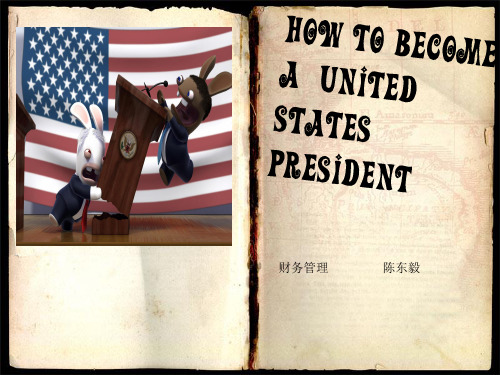
Thank you
Win the presidential election.
You will need to do more than win the popular vote, which is the tally of all votes in your favor. You will also need to win the electoral college. 270 votes and you've got it! Each state has a certain number of electors based on its size and population. To become president, one candidate must have more electoral votes than the other. In the event of a tie, the House of Representatives will decide the election
Attend your party's convention
Once you emerge(浮现) as the strongest candidate in your political party, you will hold a convention where all the delegates will pledge(保证) their support for your candidacy.
财务管理
陈东毅
requirements
natural-born citizen of the United States at least 35 years old
美国总统竞选发言稿英文

美国总统竞选发言稿英文Ladies and gentlemen, citizens of the United States, thank you for being here today. It is an honor and a privilege to stand before you as a candidate for the highest office in our great nation. I am humbled by the opportunity to serve and to lead, and I want to share with you my vision for America, my plans for the future, and the reasons why I am the best person to lead this country forward.I stand here today as a proud American, a proud citizen of a country that has provided so much for so many. I believe in the promise of our nation, the promise of freedom, equality, and opportunity for all. But I also recognize that we have work to do, challenges to face, and changes to make in order to ensure that every American has the opportunity to pursue their dreams and live a life of dignity and security.As I travel around this great country, I am inspired by the resilience and determination of the American people. I have seen hardworking families, innovative entrepreneurs, and dedicated public servants who are all working to make our country better. But I have also seen the struggles and the hardships that so many Americans face – the lack of affordable healthcare, the high cost of education, the threat of climate change, the systemic injustices in our society. These are the challenges that we must address, these are the issues that we must confront, and these are the reasons why I am running for President of the United States.I believe in a future where every American has access to high-quality, affordable healthcare. This is not a privilege for the few, but a right for all. We must work to expand access to healthcare,lower prescription drug prices, and ensure that no one in this country goes bankrupt because they got sick.I believe in a future where every child has access to a high-quality education, regardless of their zip code or their family’s income. As President, I will work to invest in our public schools, to make college more affordable, and to provide more opportunities for vocational and technical training. Education is the key to unlocking the potential of our youth, and we must make sure that every child has the chance to succeed.I believe in a future where we address the urgent threat of climate change. The science is clear, and the impacts are already being felt. As President, I will work to invest in renewable energy, to reduce our carbon emissions, and to protect our planet for future generations.I believe in a future where we address systemic injustices in our society – from racial inequality, to economic inequality, to the criminal justice system. We must work to build a more just and equitable society, where every American is treated with dignity and respect.But we cannot achieve any of these goals if we continue to be divided as a country. We cannot continue to have a government that is paralyzed by partisan politics, where progress is stalled and the needs of the people are ignored. We need leadership that brings Americans together, that listens to all voices, and that finds common ground to move our country forward.I believe that I am the leader that our country needs at this moment.I have a track record of bringing people together, of finding solutions to complex problems, and of fighting for the needs of the American people. I believe in the power of our democracy, and I am committed to working tirelessly to serve the people of this nation.So I ask for your support, for your trust, and for your partnership in building a better future for America. Together, we can achieve great things, and together, we can ensure that the promise of our nation is fulfilled for generations to come.Thank you, and God bless America.。
美国总统竞选演讲稿英文

It is an honor and a privilege to stand before you today as a candidate for the presidency of the United States of America. I am here to share with you my vision for our great nation, and to ask for your support in making it a reality.America has always been the land of opportunity, a beacon of hope for people from all corners of the world. We have achieved greatness through our ingenuity, our hard work, and our unwavering commitment to the principles upon which our nation was founded. However, we have also faced challenges and setbacks along the way. Today, we stand at a crossroads, and it is time for us to come together and forge a brighter future for ourselves and for our children.First and foremost, I want to address the issue of economic prosperity. Our economy has been struggling in recent years, with too many families facing financial hardship. It is my goal to create a strong, thriving economy that works for everyone, not just the wealthy few.To achieve this, I will take the following steps:1. Invest in infrastructure: We need to rebuild and modernize our roads, bridges, airports, and public transportation systems. This will create jobs, improve our quality of life, and make America more competitive in the global market.2. Support small businesses: Small businesses are the backbone of our economy. I will provide them with the resources and support they need to grow and thrive, and I will eliminate unnecessary regulations that hinder their success.3. Encourage innovation: America has always been a leader in innovation, but we need to continue to foster this spirit. I will invest in research and development, and I will promote policies that encourage entrepreneurs to take risks and create new jobs.4. Create fair trade agreements: We need to ensure that our trade agreements are fair and beneficial for all parties involved. I will negotiate new trade deals that protect American jobs and promote economic growth.In addition to economic prosperity, I am committed to ensuring that every American has access to quality healthcare. Healthcare should not be a luxury, but a right. I will take the following actions to achieve this goal:1. Expand access to healthcare: I will work to ensure that every American has access to affordable, quality healthcare. This includes expanding Medicaid, implementing a public option, and supporting community health centers.2. Lower prescription drug prices: The cost of prescription drugs is skyrocketing, and it is putting an unbearable burden on American families. I will negotiate lower prices with pharmaceutical companies and implement policies to reduce the cost of prescription drugs.3. Prevent chronic diseases: Chronic diseases are the leading cause of death and disability in our country. I will invest in public health initiatives to prevent chronic diseases, such as diabetes and heart disease, and improve the overall health of our nation.I am also deeply concerned about the state of our environment. Climate change is a real and urgent threat, and we must take action now to mitigate its effects. I will take the following steps to protect our planet:1. Transition to renewable energy: I will invest in renewable energy sources, such as wind, solar, and hydroelectric power, and phase out fossil fuels. This will create jobs, reduce pollution, and help us combat climate change.2. Preserve our natural resources: I will work to preserve our natural resources, such as our forests, rivers, and oceans. This includes implementing stricter regulations on pollution and protecting endangered species.3. Support sustainable agriculture: I will promote sustainable agricultural practices that protect our soil, water, and air, and reduce greenhouse gas emissions.In addition to these key issues, I am committed to addressing the following:1. Education: I will invest in our public schools and make college affordable for all Americans. Education is the key to our future, and we must ensure that every child has access to a quality education.2. Immigration: I will implement a fair and humane immigration policy that recognizes the contributions of immigrants to our country. We must come together as a nation and embrace diversity.3. National security: I will ensure that our military is strong and capable of defending our nation. I will also work to prevent conflicts and promote peace around the world.In conclusion, I am running for president because I believe in America.I believe in the power of our people, the strength of our values, and the promise of our future. I am ready to lead our nation forward, and I ask for your support.Together, we can create a future where every American has the opportunity to achieve their dreams. Together, we can build a stronger, more prosperous, and more just America.Thank you, and God bless America.。
美国总统选举英文版
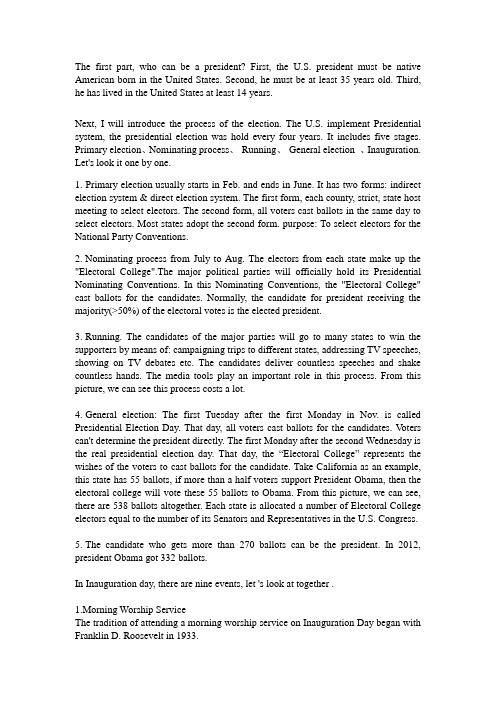
The first part, who can be a president? First, the U.S. president must be native American born in the United States. Second, he must be at least 35 years old. Third, he has lived in the United States at least 14 years.Next, I will introduce the process of the election. The U.S. implement Presidential system, the presidential election was hold every four years. It includes five stages. Primary election、Nominating process、Running、General election 、Inauguration. Let's look it one by one.1. Primary election usually starts in Feb. and ends in June. It has two forms: indirect election system & direct election system. The first form, each county, strict, state host meeting to select electors. The second form, all voters cast ballots in the same day to select electors. Most states adopt the second form. purpose: To select electors for the National Party Conventions.2.Nominating process from July to Aug. The electors from each state make up the "Electoral College".The major political parties will officially hold its Presidential Nominating Conventions. In this Nominating Conventions, the "Electoral College" cast ballots for the candidates. Normally, the candidate for president receiving the majority(>50%) of the electoral votes is the elected president.3.Running. The candidates of the major parties will go to many states to win the supporters by means of: campaigning trips to different states, addressing TV speeches, showing on TV debates etc. The candidates deliver countless speeches and shake countless hands. The media tools play an important role in this process. From this picture, we can see this process costs a lot.4.General election: The first Tuesday after the first Monday in Nov. is called Presidential Election Day. That day, all voters cast ballots for the candidates. V oters can't determine the president directly. The first Monday after the second Wednesday is the real presidential election day. That day, the “Electoral College”represents the wishes of the voters to cast ballots for the candidate. Take California as an example, this state has 55 ballots, if more than a half voters support President Obama, then the electoral college will vote these 55 ballots to Obama. From this picture, we can see, there are 538 ballots altogether. Each state is allocated a number of Electoral College electors equal to the number of its Senators and Representatives in the U.S. Congress.5.The candidate who gets more than 270 ballots can be the president. In 2012, president Obama got 332 ballots.In Inauguration day, there are nine events, let 's look at together .1.Morning Worship ServiceThe tradition of attending a morning worship service on Inauguration Day began with Franklin D. Roosevelt in 1933.2.Procession to the CapitolBy tradition, the outgoing President accompanies the President-elect to the Capitol for the swearing-in ceremony.3.Vice President’s Swearing-In CeremonyUntil 1937, the Vice President was sworn into office in the Senate.4.President’s Swearing-In Ceremony5.Inaugural AddressSince George Washington in 1789, every President has delivered an Inaugural address.6.Departure of the Outgoing PresidentFollowing the inaugural ceremony on the west front of the U.S. Capitol, the outgoing President and First Lady leave the Capitol to begin their post-presidential lives.7.Inaugural LuncheonSince 1953, a luncheon was hosted at the U.S. Capitol for the new President, Vice President, and guests.8.Inaugural ParadeWhile early parades were mostly military escorts, by 1841, floats, citizens groups, and bands became standard.9.Inaugural BallThe first Inaugural ball in Washington was thrown for James and Dolley Madison in 1809.The final part is presidential oath. Firstly, I will introduce some details about the oath. Later, I will show you a short video about the oath of the president Obama.1.Presidents say their name after the first " I"2.Presidents raise their right hand and put their left hand on the bible while swearing in.3.The Chief Justice of the Supreme Court(最高法院首席法官) swears in the President of the United States.4.The swearing in ceremony was held in Washington, D.C.5.It is customary for presidents to add the words "So help me God " to the end of the oath .6.Presidents give an inaugural speech after their oath.。
2020年希拉里宣布竞选美国总统中英双语演讲_竞选演讲稿_

2020年希拉里宣布竞选美国总统中英双语演讲
"I'm running for president,Americans have fought their way back from tough economic times, but the deck is still stacked in favor of those at the top. Everyday Americans need a champion, and I want to be that champion so you can do more than just get by. You can get ahead and stay ahead. Because when families are strong, America is strong."
“我正在竞选总统。
美国民众正努力从艰难的经济形势中脱身,但这一平台仍然在向高端阶层倾斜。
美国民众每天都需要一名冠军,我想成为这一冠军,这样你们可以做得更多,而不是仅作看客。
你们可以向前迈步、置身未来。
因为只有家庭强大了,美国才强大。
”
"So I'm hitting the road to earn your vote. Because it's your time and I hope you'll join me on this journey."
“因此,我正在努力争取你们的选票。
因为这是你们的时代,我希望你们能够在这一过程中加入我的阵营。
”。
竞选美国总统英文演讲稿
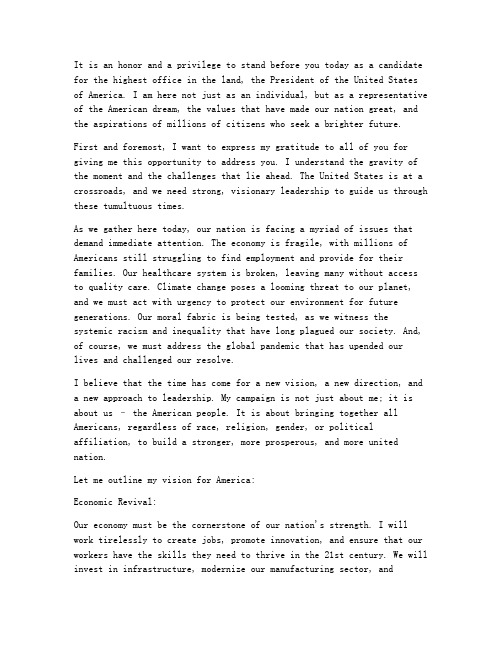
It is an honor and a privilege to stand before you today as a candidate for the highest office in the land, the President of the United States of America. I am here not just as an individual, but as a representative of the American dream, the values that have made our nation great, and the aspirations of millions of citizens who seek a brighter future.First and foremost, I want to express my gratitude to all of you for giving me this opportunity to address you. I understand the gravity of the moment and the challenges that lie ahead. The United States is at a crossroads, and we need strong, visionary leadership to guide us through these tumultuous times.As we gather here today, our nation is facing a myriad of issues that demand immediate attention. The economy is fragile, with millions of Americans still struggling to find employment and provide for their families. Our healthcare system is broken, leaving many without access to quality care. Climate change poses a looming threat to our planet, and we must act with urgency to protect our environment for future generations. Our moral fabric is being tested, as we witness the systemic racism and inequality that have long plagued our society. And, of course, we must address the global pandemic that has upended ourlives and challenged our resolve.I believe that the time has come for a new vision, a new direction, anda new approach to leadership. My campaign is not just about me; it is about us – the American people. It is about bringing together all Americans, regardless of race, religion, gender, or politicalaffiliation, to build a stronger, more prosperous, and more united nation.Let me outline my vision for America:Economic Revival:Our economy must be the cornerstone of our nation's strength. I will work tirelessly to create jobs, promote innovation, and ensure that our workers have the skills they need to thrive in the 21st century. We will invest in infrastructure, modernize our manufacturing sector, anddevelop renewable energy sources to secure our energy independence. We will also crack down on corporate greed and ensure that the benefits of economic growth are shared by all Americans.Healthcare for All:Healthcare should be a right, not a privilege. I will fight to ensurethat every American has access to affordable, high-quality healthcare. We will expand Medicare to cover all Americans, including those under 65, and make it easier for people to access prescription drugs. We will also invest in research and development to combat diseases and improve healthcare outcomes for all.Climate Action:The climate crisis is an existential threat to our planet, and we must act now. I will lead the United States in a global effort to combat climate change, investing in renewable energy, reforesting our lands,and transitioning to a carbon-neutral economy. We will also support developing nations in their efforts to mitigate the impacts of climate change.Social Justice and Equality:We must confront the systemic racism and inequality that have long been a stain on our nation. I will work to reform our criminal justice system, promote equal opportunity in education and employment, and fight for the rights of all Americans, including the LGBTQ+ community and immigrants. We will build a society where everyone has a fair shot at success and where our diversity is celebrated as our greatest strength.Global Leadership:The United States must once again be a beacon of hope and a force for good in the world. I will work to rebuild alliances with our allies, engage in diplomatic efforts to resolve conflicts, and promote peace and stability across the globe. We will stand firm against tyranny and oppression, and we will support the democratic ideals that have guided our nation since its inception.In order to achieve this vision, we must come together as a nation. We must bridge the divides that have been created by politics, ignorance, and fear. We must recognize that we are all in this together, and that our collective strength is our greatest asset.As your President, I will listen to your concerns, hear your stories, and fight for your rights. I will be a voice for the voiceless, a champion for the underdog, and a leader who will never compromise on the values that define us as Americans.I ask for your support, your votes, and your commitment to our shared future. Together, we can overcome the challenges that lie ahead andbuild a brighter, more hopeful America.In conclusion, let me leave you with this thought: Our nation is at a critical juncture. The choice we make in the coming months will determine the kind of world we leave behind for our children and grandchildren. Will we choose division and despair, or will we choose unity and progress? The answer lies in each of us.Thank you, and God bless America.[Applause]。
美国大选介绍英文版
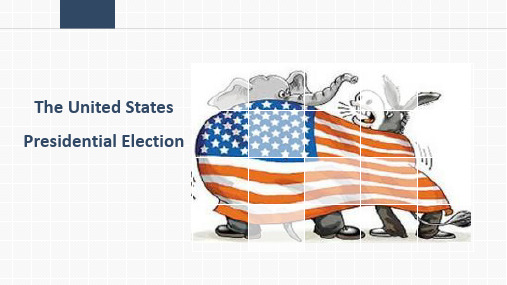
Thsentatives Conference
January June July August November
Primary election
Running Inaugural address
Election
Political experience In recent decades, the presidential nominees of both major parties have been either incumbent presidents, sitting or former vice presidents, sitting or former U.S. Senators, or sitting or former state Governors.
The United States Presidential Election
The United States presidential election is in the first Tuesday of November. This day is also known as the United States presidential election day, coinciding with the general elections of various other federal, states and local races. The fifty-eighth presidential election of the United states is held in 2016.
Candidates of 2016
Hillary Clinton Deocratic Party
Donald Trump Republic Party
美国作文之美国总统竞选演讲稿
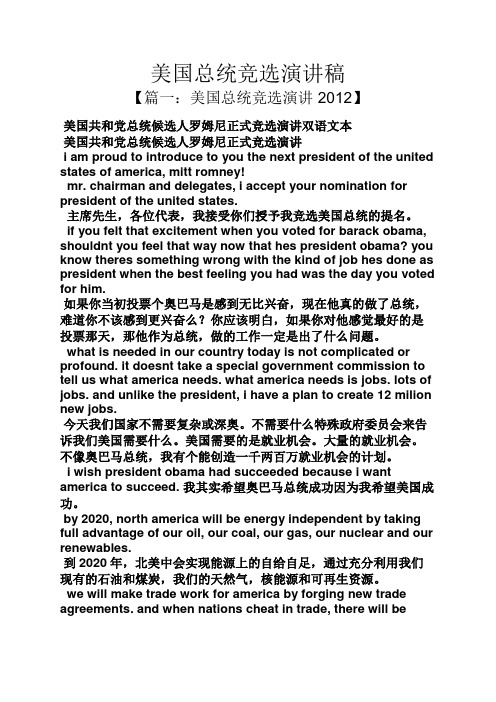
美国总统竞选演讲稿【篇一:美国总统竞选演讲 2012】美国共和党总统候选人罗姆尼正式竞选演讲双语文本美国共和党总统候选人罗姆尼正式竞选演讲i am proud to introduce to you the next president of the united states of america, mitt romney!mr. chairman and delegates, i accept your nomination for president of the united states.主席先生,各位代表,我接受你们授予我竞选美国总统的提名。
if you felt that excitement when you voted for barack obama, shouldnt you feel that way now that hes president obama? you know theres something wrong with the kind of job hes done as president when the best feeling you had was the day you voted for him.如果你当初投票个奥巴马是感到无比兴奋,现在他真的做了总统,难道你不该感到更兴奋么?你应该明白,如果你对他感觉最好的是投票那天,那他作为总统,做的工作一定是出了什么问题。
what is needed in our country today is not complicated or profound. it doesnt take a special government commission to tell us what america needs. what america needs is jobs. lots of jobs. and unlike the president, i have a plan to create 12 milion new jobs.今天我们国家不需要复杂或深奥。
美国大选 介绍 英文版 Presidential Election

Video clip
THANKS!
in turn directly elect the President and Vice President.
Spring 2015
procedure
1
2 3 4
Eligibility requirements
Candidates announce their intentions to run, and (if necessary) file their Statement of Candidacy with the Federal Election Commission
The Procedure
National Representatives Conference
January June July August November
Primary election
Running
Inaugural address
Election
Political experience In recent decades, the presidential nominees of both major parties have been either incumbent presidents, sitting or former vice presidents, sitting or former U.S. Senators, or sitting or former state Governors.
Candidates of 2016
Hillary Clinton Deocratic Party
Donald Trump Republic Party
The winner is…
竞选美国总统的英语作文
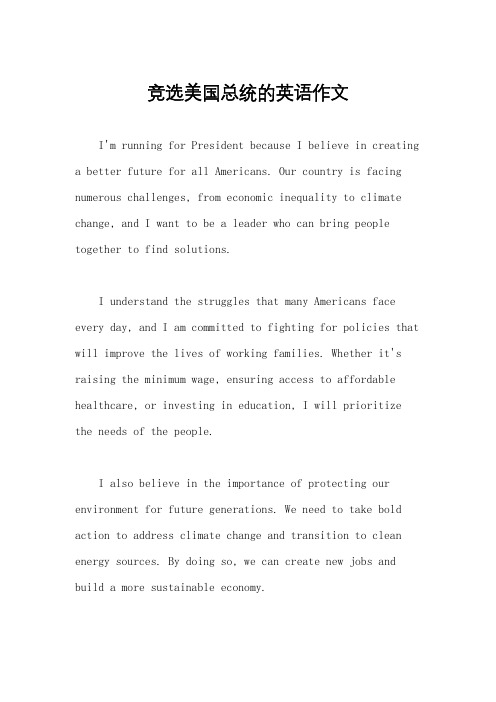
竞选美国总统的英语作文I'm running for President because I believe in creating a better future for all Americans. Our country is facing numerous challenges, from economic inequality to climate change, and I want to be a leader who can bring people together to find solutions.I understand the struggles that many Americans face every day, and I am committed to fighting for policies that will improve the lives of working families. Whether it's raising the minimum wage, ensuring access to affordable healthcare, or investing in education, I will prioritize the needs of the people.I also believe in the importance of protecting our environment for future generations. We need to take bold action to address climate change and transition to clean energy sources. By doing so, we can create new jobs and build a more sustainable economy.As President, I will work to promote equality andjustice for all. This means advocating for criminal justice reform, protecting the rights of marginalized communities, and working to end discrimination in all its forms. We must strive to create a society where everyone has theopportunity to thrive.I am not a career politician, but I bring a fresh perspective and a dedication to serving the American people.I am ready to roll up my sleeves and get to work, and Ihope to earn your support in this important election. Thank you.。
美国总统竞选的英语演讲稿
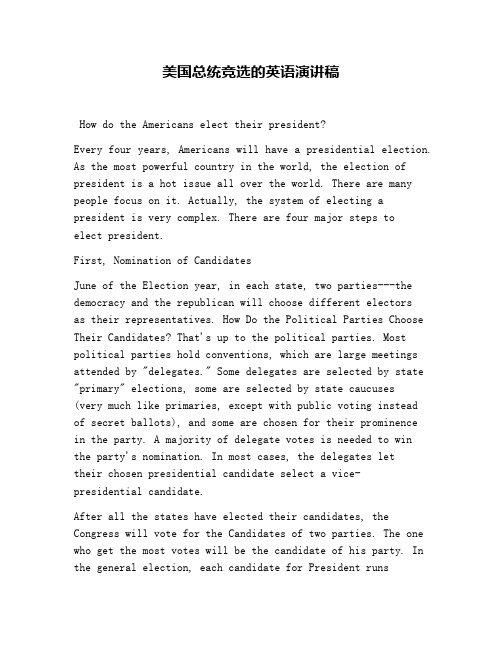
美国总统竞选的英语演讲稿How do the Americans elect their president?Every four years, Americans will have a presidential election. As the most powerful country in the world, the election of president is a hot issue all over the world. There are many people focus on it. Actually, the system of electing a president is very complex. There are four major steps toelect president.First, Nomination of CandidatesJune of the Election year, in each state, two parties---the democracy and the republican will choose different electorsas their representatives. How Do the Political Parties Choose Their Candidates? That's up to the political parties. Most political parties hold conventions, which are large meetings attended by "delegates." Some delegates are selected by state "primary" elections, some are selected by state caucuses(very much like primaries, except with public voting insteadof secret ballots), and some are chosen for their prominencein the party. A majority of delegate votes is needed to winthe party's nomination. In most cases, the delegates lettheir chosen presidential candidate select a vice-presidential candidate.After all the states have elected their candidates, the Congress will vote for the Candidates of two parties. The one who get the most votes will be the candidate of his party. In the general election, each candidate for President runstogether. They must be at least 35 years of age, they must be native-born citizens of the United States, and they must have been residents of the U.S. for at least 14 years. (Also, a person cannot be elected to a third term as President.)Second, the Campaign PeriodThe candidates of the parties will hold a campaign throughout the country. This is the most important period of election of president, usually from September to November. The forms of campaign include, give speeches in different states, and meet with votes and public debt with his rival candidate. The purpose of campaign is to gain support of people as much as possible. This is the most wonderful part.Third, Election for President VotersThe national presidential election actually consists of a separate election in each of the 50 states and the District of Columbia; in these 51 elections, the voters are really voting for "electors" pledged to one of the tickets. These electors make up the "Electoral College." Each state has the same number of electors as it has senators and representatives (there are two senators from each state, but the number of representatives depends on the state population in the most recent census). The District of Columbia, although it isn't a state, also participates in presidential elections -- it currently has three electors. Generally speaking, the voters will vote for the candidate who represents his party.Finally, Voters Vote the PresidentThe Electoral College then votes for President and for Vice-President, with each elector casting one vote; these votes are called electoral votes. Each elector is pledged to vote for particular candidates for President and Vice-President. In most elections, all the electors vote in accordance with the pledge they made; it is not clear what would happen in the unlikely event that a large number of electors violated their pledge and voted differently.Normally, one of the candidates for President receives a majority (more than half) of the electoral votes; that person is elected President. That candidate's vice-presidential running mate will then also receive a majority of electoral votes (for Vice-President), and that person is elected Vice-President. The result will be announced in the sixth day of January, the next year of election year.Through the above complex process, the new president will be elected. Although there are many arguments pro and con the Electoral College, but this system does guarantee that the person elected President has substantial support distributed throughout the U.S. The Electoral College has also been a major factor in the United States' long-term political stability.。
美国总统选举英文介绍
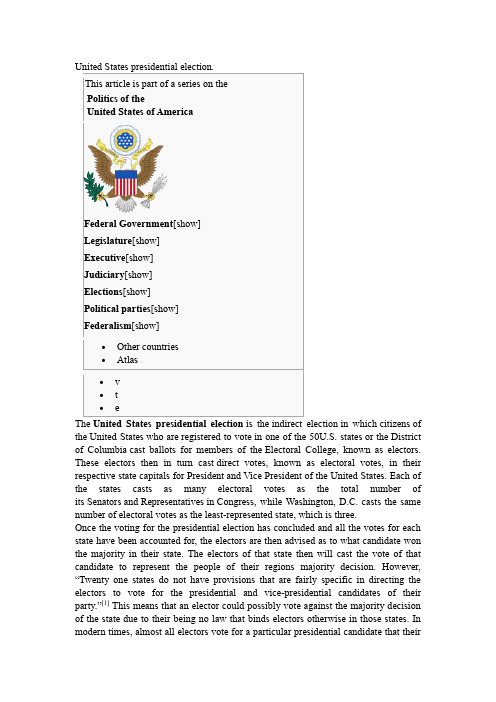
election in which citizens of the United States who are registered to vote in one of the 50U.S. states or the District of Columbia cast ballots for members of the Electoral College, known as electors. These electors then in turn cast direct votes, known as electoral votes, in their respective state capitals for President and Vice President of the United States. Each of the states casts as many electoral votes as the total number of its Senators and Representatives in Congress, while Washington, D.C. casts the same number of electoral votes as the least-represented state, which is three.Once the voting for the presidential election has concluded and all the votes for each state have been accounted for, the electors are then advised as to what candidate won the majority in their state. The electors of that state then will cast the vote of that candidate to represent the people of their regions majority decision. However, “Twenty one states do not have provisions that are fairl y specific in directing the electors to vote for the presidential and vice-presidential candidates of their party.”[1] This means that an elector could possibly vote against the majority decision of the state due to their being no law that binds electors otherwise in those states. In modern times, almost all electors vote for a particular presidential candidate that theirstates majority decided upon; thus, the results of the election can generally be determined based on the state-by-state popular vote. The candidate who receives an absolute majority of electoral votes for President or Vice President (currently, at least 270 out of a total of 538) is then projected to be elected to that office. If no candidate receives an absolute majority of electoral votes for President, the House of Representatives chooses the President; if no candidate receives an absolute majority for Vice President, the Senate chooses the Vice President.These presidential elections occur quadrennially. Registered voters cast their ballots on Election Day, which since 1845 has been the Tuesday after the first Monday in November (i.e.,the first Tuesday after November 1),[2][3][4] coinciding with the general elections of various other federal, state, and local races. The Electoral College electors then schedule to formally cast their electoral votes on the first Monday after the second Wednesday of December (i.e., the first Monday after December 12) at their respective state capitals. Congress then certify the results in early January, and the presidential term begins on Inauguration Day, which since the passage of the Twentieth Amendment has been set at January 20.The Electoral College and its procedure is established in the U.S. Constitution by Article II, Section 1, Clauses 2 and 4; and the Twelfth Amendment(which replaced Clause 3 after it was ratified in 1804). Under Article II, Section 1, Clause 2, the manner for choosing electors is determined by each state legislature, not directly by the federal government. Many state legislatures used to select their electors directly instead of using any form of popular vote, but the political parties in the various states now conduct their own separate elections to help choose their slate of electors. The Twenty-third Amendment, ratified in 1961, then granted electoral votes to Washington, D.C. Electors can vote for anyone, butunpledged electors or faithless electors have been rare in modern times.The nomination process, consisting of the primary elections and caucuses and the nominating conventions, was not specified in the Constitution, but was developed over time by the states and thepolitical parties. These primary elections are generally held between January and June before the general election in November, while the nominating conventions are held in the summer. This too is an indirect election process, one in which voters in the various states, the District of Columbia, as well as those in U.S. territories, cast ballots for a slate of delegates to a political party's nominating convention, who then in turn elect their party's presidential nominee. Each party's presidential nominee or the convention may then choose a vice presidential running mate to join with him or her on the same ticket, and this choice is often rubber-stamped by the conventions, depending on that convention's rules. Because of changes to national campaign finance laws since the 1970s regarding the disclosure of contributions for federal campaigns, presidential candidates from the major political parties usually declare their intentions to run as early as the spring of the previous calendar year before the election (almost 18 months before Inauguration Day).[5]A 2016 general election ballot, listing the presidential and vice presidential candidates Contents[hide]∙1History∙2Procedureo 2.1Eligibility requirementso 2.2Nominating processo 2.3The popular vote on Election Dayo 2.4Electoral collegeo 2.5Election calendar∙3Trendso 3.1Previous experienceo 3.2Technology and media∙4Criticismso 4.1Proposed changes to the election process∙5Electoral college results∙6V oter turnout∙7Financial disclosures∙8Presidential coattailso8.1Comparison with other U.S. general elections∙9See also∙10Notes∙11External linksHistory[edit]Article Two of the United States Constitution originally established the method of presidential elections, including the Electoral College. This was a result of a compromise between those constitutional framers who wanted the Congress to choose the president, and those who preferred a national popular vote.[6]Each state is allocated a number of electors that is equal to the size of its delegation in both houses of Congress combined. With the ratification of the 23rd Amendment to the Constitution in 1961, the District of Columbia is also granted a number of electors, equal to the number of those held by the least populous state. However, U.S. territories are not represented in the Electoral College.Constitutionally, the manner for choosing electors is determined within each state by its legislature. During the first presidential election in 1789, only 6 of the 13 original states chose electors by any form of popular vote.[7] Gradually throughout the years, the states began conducting popular elections to help choose their slate of electors, resulting in the overall, nationwide indirect election system that it is today.Under the original system established by Article Two, electors could cast two votes to two different candidates for president. The candidate with the highest number of votes (provided it was a majority of the electoral votes) became the president, and the second-place candidate became the vice president. This presented a problem during the presidential election of 1800 when Aaron Burrreceived the same number of electoral votes as Thomas Jefferson and challenged Jefferson's election to the office. In the end, Jefferson was chosen as the president because of Alexander Hamilton's influence in the House of Representatives. This added to the deep rivalry between Burr and Hamilton which resulted in their famous 1804 duel.In response to the 1800 election, the 12th Amendment was passed, requiring electors to cast two distinct votes: one for President and another for Vice President. While this solved the problem at hand, it ultimately had the effect of lowering the prestige of the Vice Presidency, as the office was no longer for the leading challenger for the Presidency. The separate ballots for President and Vice President became something of a moot issue later in the 19th century when it became the norm for popular elections to determine a state's Electoral College delegation. Electors chosen this way are pledged to vote for a particular presidential and vice presidential candidate (offered by the same political party). So, while the Constitution says that the President and Vice President are chosen separately, in practice they are chosen together.The 12th Amendment also established rules when no candidate wins a majority vote in the Electoral College. In the presidential election of 1824, Andrew Jackson received a plurality, but not a majority, of electoral votes cast. The election was thrown to the House of Representatives, and John Quincy Adams was elected to the presidency. A deep rivalry resulted between Andrew Jackson and House Speaker Henry Clay, who had also been a candidate in the election.Since 1824, aside from the occasional "faithless elector," the popular vote determines the winner of a presidential election by determining the electoral vote, as each state or district's popular vote determines its electoral college vote. Although the nationwide popular vote does not directly determine the winner of a presidential election, it does strongly correlate with who is the victor. In 52 of the 56 total elections held so far (about 93 percent), the winner of the national popular vote has also carried the Electoral College vote. The winners of the nationwide popular vote and the Electoral College vote differ only in close elections. In highly competitive elections, candidates focus on turning out their vote in the contested swing states critical to winning an electoral college majority, so they do not try to maximize their popular vote by real or fraudulent vote increases in one-party areas.[8]However, candidates can fail to get the most votes in the nationwide popular vote in a Presidential election and still win that election. In the 1824 election, Jackson won the popular vote, but no one received the majority of electoral votes. According to the12th Amendment in the Constitution, the House of Representatives must choose the president out of the top 3 people in the election. Clay had come fourth, so he threw his support to Adams, who then won. Because Adams later named Clay his Secretary of State, Jackson's supporters claimed that Adams gained the presidency by making a deal with Clay. Charges of a "corrupt bargain" followed Adams through his term.Comparison of the popular vote totals since 1900.RepublicanDemocratAll other candidates togetherThen in 1876, 1888, 2000, and 2016, the winner of electoral vote lost the popular vote outright. Numerous constitutional amendments have been submitted seeking to replace the Electoral College with a direct popular vote, but none has ever successfully passed both Houses of Congress. Another alternate proposal is the National Popular V ote Interstate Compact, an interstate compact whereby individual participating states agree to allocate their electors based on the winner of the national popular vote instead of just their respective statewide results.The presidential election day was established on a Tuesday in the month of November because of the factors involved (weather, harvests and worship). When voters used to travel to the polls by horse, Tuesday was an ideal day because it allowed people to worship on Sunday, ride to their county seat on Monday, and vote on Tuesday–all before market day, Wednesday. The month of November also fits nicely between harvest time and harsh winter weather, which could be especially bad to people traveling by horse and buggy.[9]Until 1937, presidents were not sworn in until March 4 because it took so long to count and report ballots, and because of the winner's logistical issues of moving to the capital. With better technology and the 20th Amendment being passed, presidential inaugurations were moved to noon on January 20–allowing presidents to start their duties sooner.[9]The Federal Election Campaign Act of 1971 was enacted to increase disclosure of contributions for federal campaigns. Subsequent amendments to law require that candidates to a federal office must file a Statement of Candidacy with the Federal Election Commission before they can receive contributions aggregating in excess of $5,000 or make expenditures aggregating in excess of $5,000. Thus, this began a trend of presidential candidates declaring their intentions to run as early as the Spring of the previous calendar year so they can start raising and spending the money needed for their nationwide campaign.[5]The first president, George Washington, was elected as an independent. Since the election of his successor, John Adams, in 1796, all winners of U.S. presidential elections have represented one of two major parties. Third parties have taken secondplace only twice, in 1860 and 1912. The last time a third (independent) candidate achieved significant success (although still finishing in third place) was in 1992, and the last time a third-party candidate received any electoral votes not from faithless electors was in 1968.Procedure[edit]Eligibility requirements[edit]The hand-written copy of the natural-born-citizen clause as it appeared in 1787 Article Two of the United States Constitution stipulates that for a person to serve as President, the individual must be a natural-born citizen of the United States, at least35 years old, and a resident of the United States for a period of no less than 14 years.A candidate may start running his or her campaign early before turning 35 years old or completing 14 years of residency, but must meet the age and residency requirements byInauguration Day. The Twenty-second Amendment to the Constitution also sets a term limit: a President cannot be elected to more than two terms.The U.S. Constitution also has two provisions that apply to all federal offices in general, not just the presidency. Article I, Section 3, Clause 7 states that if the U.S. Congress convicts any officer on impeachment, they may also bar that person from holding any public office in the future. And Section 3 of the Fourteenth Amendment prohibits the election to any federal office of any person who had held any federal or state office and then engaged in insurrection, rebellion or treason; this disqualification can be waived if such an individual gains the consent of two-thirds of both houses of Congress.In addition, the Twelfth Amendment establishes that the Vice-President must meet all of the qualifications of being a President.Although not a mandatory requirement, Federal campaign finance laws including the Federal Election Campaign Act state that a candidate who intends to receive contributions aggregating in excess of $5,000 or make expenditures aggregating in excess of $5,000, among others, must first file a Statement of Candidacy with the Federal Election Commission.[10] This has led presidential candidates, especially members from the two major political parties, to officially announce their intentions to run as early as the spring of the previous calendar year so they can start raising or spending the money needed for their nationwide campaign.[5] Potential candidates usually form exploratory committees even earlier to determining the feasibility of them actually running.Nominating process[edit]Main articles: United States presidential primary and United States presidential nominating conventionA 2008 Democratic caucus meeting in Iowa City, Iowa. The Iowa caucuses are traditionally the first major electoral event of presidential primaries and caucuses.Madison Square Garden in New York City, the site of the 1976, 1980, and 1992 Democratic National Conventions; and the 2004 Republican National Convention.The floor of the 2008 Republican National Convention at the Xcel Energy Center in Saint Paul, Minnesota.The modern nominating process of U.S. presidential elections consists of two major parts: a series of presidential primary elections and caucuses held in each state, and the presidential nominating conventions held by each political party. This process was never included in the United States Constitution, and thus evolved over time by the political parties to clear the field of candidates.The primary elections are run by state and local governments, while the caucuses are organized directly by the political parties. Some states hold only primary elections, some hold only caucuses, and others use a combination of both. These primaries and caucuses are staggered generally between January and June before the federal election, with Iowa and New Hampshire traditionally holding the first presidential state caucus and primary, respectively.Like the general election, presidential caucuses or primaries are indirect elections. The major political parties officially vote for their presidential candidate at their respective nominating conventions, usually all held in the summer before the federal election. Depending on each state's law and state's political party rules, when voters cast ballots for a candidate in a presidential caucus or primary, they may be voting to awarddelegates "bound" to vote for a candidate at the presidential nominating conventions, or they may simply be expressing an opinion that the state party is not bound to follow in selecting delegates to their respective national convention.Unlike the general election, voters in the U.S. territories can also elect delegates to the national conventions. Furthermore, each political party can determine how many delegates to allocate to each state and territory. In 2012 for example, the Democratic and Republican party conventions each used two different formulas to allocate delegates. The Democrats-based theirs on two main factors: the proportion of votes each state gave to the Democratic candidate in the previous three presidential elections, and the number of electoral votes each state had in the Electoral College.[11] In contrast, the Republicans assigned to each state 10 delegates, plus 3 delegates per congressional district.[12] Both parties then gave fixed amounts of delegates to each territory, and finally bonus delegates to states and territories that passed certain criteria.[11][12]Along with delegates chosen during primaries and caucuses, state and U.S. territory delegations to both the Democratic and Republican party conventions also include "unpledged" delegates that have a vote. For Republicans, they consist of the three top party officials from each state and territory. Democrats have a more expansive group of unpledged delegates called "superdelegates", who are party leaders and elected officials.Each party's presidential candidate also chooses a vice presidential nominee to run with him or her on the same ticket, and this choice is rubber-stamped by the convention.If no single candidate has secured a majority of delegates (including both pledged and unpledged), then a "brokered convention" results. All pledged delegates are then "released" and are able to switch their allegiance to a different candidate. Thereafter, the nomination is decided through a process of alternating political horse trading, and additional rounds of re-votes.[13][14][15][16]The conventions have historically been held inside convention centers, but since the late 20th century both the Democratic and Republican parties have favoredsports arenas and domed stadiums to accommodate the increasing attendance.The popular vote on Election Day[edit]A Texas voter about to mark a selection for president on a ballot, 2008 Election Day Under the United States Constitution, the manner of choosing electors for the Electoral College is determined by each state's legislature. Although each state designates electors by popular vote, other methods are allowed. For instance, insteadof having a popular vote, a number of states used to select presidential electors by a direct vote of the state legislature itself.However, federal law does specify that all electors must be selected on the same day, which is "the first Tuesday after the first Monday in November," i.e., a Tuesday no earlier than November 2 and no later than November 8.[17] Today, the states and the District of Columbia each conduct their own popular elections on Election Day to help determine their respective slate of electors. Thus, the presidential election is really an amalgamation of separate and simultaneous state elections instead of a single national election run by the federal government.Like any other election in the United States, the eligibility of an individual for voting is set out in the Constitution and regulated at state level. The Constitution states that suffrage cannot be denied on grounds of race or color, sex or age for citizens eighteen years or older. Beyond these basic qualifications, it is the responsibility of state legislatures to regulate voter eligibility.Generally, voters are required to vote on a ballot where they select the candidate of their choice. The presidential ballot is a vote "for the electors of a candidate" meaning that the voter is not voting for the candidate, but endorsing a slate of electors pledged to vote for a specific presidential and vice presidential candidate.Many voting ballots allow a voter t o “blanket vote” for all candidates in a particular political party or to select individual candidates on a line by line voting system. Which candidates appear on the voting ticket is determined through a legal process known as ballot access. Usually, the size of the candidate's political party and the results of the major nomination conventions determine who is pre-listed on the presidential ballot. Thus, the presidential election ticket will not list every candidate running for President, but only those who have secured a major party nomination or whose size of their political party warrants having been formally listed. Laws are in effect to have other candidates pre-listed on a ticket, provided that enough voters have endorsed the candidate, usually through a signature list.The final way to be elected for president is to have one's name written in at the time of election as a write-in candidate. This is used for candidates who did not fulfill the legal requirements to be pre-listed on the voting ticket. It is also used by voters to express a distaste for the listed candidates, by writing in an alternative candidate for president such as Mickey Mouse or comedian Stephen Colbert (whose application was voted down by the South Carolina Democratic Party). In any event, a write-in candidate has never won an election for President of the United States.Because U.S. territories are not represented in the Electoral College, U.S. citizens in those areas do not vote in the general election for President. Guam has held straw polls for president since the 1980 election to draw attention to this fact.[18]Electoral college[edit]Main article: Electoral College (United States)Electoral College map showing the results of the 2016 U.S. presidential election. Republican candidate Donald Trump won the popular vote in 30 states (denoted in red) to capture 305 electoral votes (plus 1 electoral vote from Maine's second congressional district). Democraticcandidate Hillary Clinton won the popular vote in 20 states and Washington, D.C. (denoted in blue) to capture 232 electoral votes.Most state laws establish a winner-take-all system, wherein the ticket that wins a plurality of votes wins all of that state's allocated electoral votes, and thus has their slate of electors chosen to vote in the Electoral College. Maine and Nebraska do not use this method, instead giving two electoral votes to the statewide winner and one electoral vote to the winner of each Congressional district.Each state's winning slate of electors then meets at their respective state's capital on the first Monday after the second Wednesday in December to cast their electoral votes on separate ballots for President and Vice President. Although Electoral College members can technically vote for anyone under the U.S. Constitution, 24 states have laws to punish faithless electors,[19] those who do not cast their electoral votes for the person whom they have pledged to elect.In early January, the total Electoral College vote count is opened by the sitting Vice President, acting in his capacity as President of the Senate, and read aloud to a joint session of the incoming Congress, which was elected at the same time as the President.If no candidate receives a majority of the electoral vote (at least 270), the President is determined by the rules outlined by the 12th Amendment. Specifically, the selection of President would then be decided by a contingent election in a ballot of the House of Representatives. For the purposes of electing the President, each state has only one vote. A ballot of the Senate is held to choose the Vice President. In this ballot, each senator has one vote. The House of Representatives has chosen the victor of the presidential race only twice, in 1800 and 1824; the Senate has chosen the victor of the vice-presidential race only once, in 1836.If the President is not chosen by Inauguration Day, the Vice President-elect acts as President. If neither are chosen by then, Congress by law determines who shall act as President, pursuant to the 20th Amendment.Unless there are faithless electors, disputes, or other controversies, the events in December and January mentioned above are largely a formality since the winner canbe determined based on the state-by-state popular vote results. Between the general election and Inauguration Day, this apparent winner is referred to as the "President-elect" (unless it is a sitting President that has won re-election).Election calendar[edit]The typical periods of the presidential election process are as follows, with the dates corresponding to the 2016 general election:∙Spring 2015 – Candidates announce their intentions to run, and (if necessary) file their Statement of Candidacy with the Federal Election Commission ∙August 2015 to March 2016 – Primary and caucus debates∙February 1 to June 14, 2016 – Primaries and caucuses∙April to August, 2016 – Nominating conventions (including those of the minor third parties)∙September and October, 2016 – Presidential election debates∙November 8, 2016 – Election Day∙December 19, 2016 – Electors cast their electoral votes∙January 6, 2017 – Congress counts and certifies the electoral votes∙January 20, 2017 – Inauguration DayTrends[edit]Previous experience[edit]See also: List of Presidents of the United States by previous experience and List of Presidents of the United States by other offices heldJohn Adams was the first of a record-high 26 presidents who had been lawyersA number of trends in the political experience of presidents have been observed. Between 1956 and the last completed 2012 election, the presidential nominees of both major parties have been either incumbent presidents seeking re-election, sitting or former vice presidents, sitting or former U.S. Senators, or sitting or former state Governors.Fourteen Presidents have served as Vice President. However, only John Adams (1796), Thomas Jefferson (1800), Martin Van Buren (1836), Richard Nixon (1968) andGeorge H. W. Bush (1988) began their first term after winning an election. Among the remaining nine who began their first term as President according to thepresidential line of succession after their respective predecessor died or resigned from office, Theodore Roosevelt, Calvin Coolidge, Harry S. Truman, andLyndon B. Johnson were reelected. John Tyler, Millard Fillmore, Andrew Johnson, Chester A. Arthur, and Gerald Ford served as President but became president through succession and not election. Ford became President after Nixon's resignation in 1974 through the processes of the Twenty-fifth Amendment and then lost the 1976 presidential election, making him the only President to have not to have been elected to national office. Sixteen presidents had served in the Senate, including four of the five Presidents who served between 1945 and 1974. However, only three were sitting U.S. Senators at the time they were elected president (Warren G. Harding in 1920, John F. Kennedy in 1960, and Barack Obama in 2008). Major-party candidate Senators Andrew Jackson (1824), Lewis Cass (1848), Stephen Douglas (1860), Barry Goldwater (1964), George McGovern (1972), John Kerry (2004), and John。
希拉里竞选美国总统演讲中英文

希拉里竞选美国总统演讲中英文希拉里竞选美国总统期间,有过几次著名的演讲,小编将以中英文方式展示给大家。
更多相关英语演讲稿文章,请关注本栏目。
【希拉里竞选美国总统演讲中英文(篇一)】I'm getting ready for a lot of things. A lot of things.我已准备好了要做很多事,特别多的事。
It's spring, so we're starting to get the gardensready and my tomatoes are legendary here in myown neighborhood.春天到了,我们要开始了整理院子了。
在我们小区,我种的西红柿可是一个传说哦!My daughter is about to start kindergarten next year,and so we're moving just so she can belong to abetter school.我女儿明年就要上幼儿园了,所以我们准备搬家,就是为了她能上好一点儿的学校。
......My brother and I are starting our firstbusiness......我的兄弟和我正打算创业。
After five years of raising my children, I am now going back to work.五年来我一直都在带孩子。
现在我要重返职场了。
Every day we're trying to get more and more ready and more prepared. Baby boy, coming yourway.我们每天都在做准备。
现在准备是越来越充分了。
宝宝,来吧!Right now I'm applying for jobs. It's a look into what the real world will look like after college.我刚刚申请了工作,对毕业后的真实世界充满了期待。
总统竞选演讲稿英文
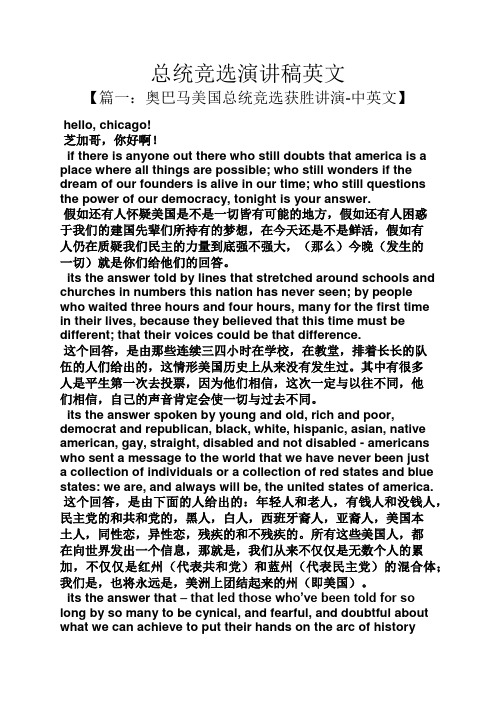
总统竞选演讲稿英文【篇一:奥巴马美国总统竞选获胜讲演-中英文】hello, chicago!芝加哥,你好啊!if there is anyone out there who still doubts that america is a place where all things are possible; who still wonders if the dream of our founders is alive in our time; who still questions the power of our democracy, tonight is your answer.假如还有人怀疑美国是不是一切皆有可能的地方,假如还有人困惑于我们的建国先辈们所持有的梦想,在今天还是不是鲜活,假如有人仍在质疑我们民主的力量到底强不强大,(那么)今晚(发生的一切)就是你们给他们的回答。
its the answer told by lines that stretched around schools and churches in numbers this nation has never seen; by peoplewho waited three hours and four hours, many for the first timein their lives, because they believed that this time must be different; that their voices could be that difference.这个回答,是由那些连续三四小时在学校,在教堂,排着长长的队伍的人们给出的,这情形美国历史上从来没有发生过。
其中有很多人是平生第一次去投票,因为他们相信,这次一定与以往不同,他们相信,自己的声音肯定会使一切与过去不同。
its the answer spoken by young and old, rich and poor, democrat and republican, black, white, hispanic, asian, native american, gay, straight, disabled and not disabled - americans who sent a message to the world that we have never been justa collection of individuals or a collection of red states and blue states: we are, and always will be, the united states of america.这个回答,是由下面的人给出的:年轻人和老人,有钱人和没钱人,民主党的和共和党的,黑人,白人,西班牙裔人,亚裔人,美国本土人,同性恋,异性恋,残疾的和不残疾的。
竞选演讲稿美国总统英文
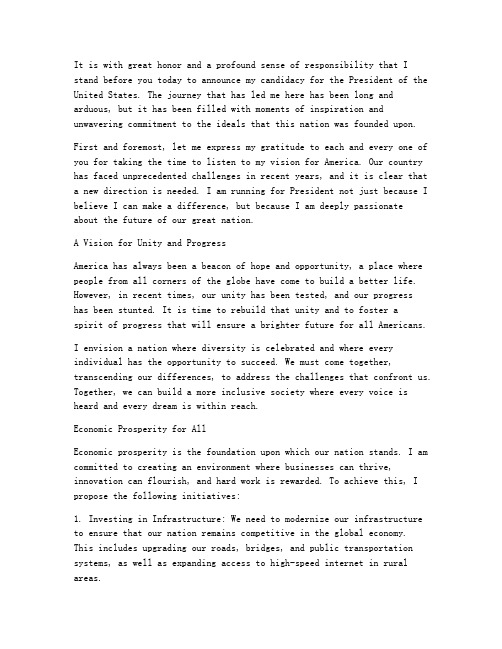
It is with great honor and a profound sense of responsibility that I stand before you today to announce my candidacy for the President of the United States. The journey that has led me here has been long and arduous, but it has been filled with moments of inspiration and unwavering commitment to the ideals that this nation was founded upon.First and foremost, let me express my gratitude to each and every one of you for taking the time to listen to my vision for America. Our country has faced unprecedented challenges in recent years, and it is clear that a new direction is needed. I am running for President not just because I believe I can make a difference, but because I am deeply passionateabout the future of our great nation.A Vision for Unity and ProgressAmerica has always been a beacon of hope and opportunity, a place where people from all corners of the globe have come to build a better life. However, in recent times, our unity has been tested, and our progresshas been stunted. It is time to rebuild that unity and to foster aspirit of progress that will ensure a brighter future for all Americans.I envision a nation where diversity is celebrated and where every individual has the opportunity to succeed. We must come together, transcending our differences, to address the challenges that confront us. Together, we can build a more inclusive society where every voice is heard and every dream is within reach.Economic Prosperity for AllEconomic prosperity is the foundation upon which our nation stands. I am committed to creating an environment where businesses can thrive, innovation can flourish, and hard work is rewarded. To achieve this, I propose the following initiatives:1. Investing in Infrastructure: We need to modernize our infrastructure to ensure that our nation remains competitive in the global economy.This includes upgrading our roads, bridges, and public transportation systems, as well as expanding access to high-speed internet in rural areas.2. Supporting Small Businesses: Small businesses are the backbone of our economy. I will work to provide them with the resources and support they need to grow and succeed, including tax relief and easier access to capital.3. Creating Jobs and Training Programs: I will prioritize job creation by investing in industries that are poised for growth, such as renewable energy, technology, and healthcare. Additionally, I will establish comprehensive training programs to ensure that workers have the skills needed to fill these new jobs.Securing Our Nation’s Sa fetyNational security is paramount, and I am committed to ensuring that our country is safe and secure. My approach to national security includes:1. Strengthening our Armed Forces: We must invest in our military to ensure that it remains the most powerful and capable force in the world. This includes modernizing our equipment and providing our service members with the best training and support.2. Combating Terrorism: We must remain vigilant against the threat of terrorism, both domestic and abroad. I will work to enhance our intelligence capabilities and to strengthen international cooperation to combat this global menace.3. Ensuring Border Security: Our borders must be secure to protect our citizens and to ensure the integrity of our nation. I will work to implement a comprehensive immigration policy that balances the need for secure borders with the opportunity for legal immigration.Education for a Bright FutureEducation is the key to a bright future, and I am committed to ensuring that every child in America has access to a quality education. My plan includes:1. Investing in Public Education: We must provide our schools with the resources they need to succeed, including funding for technology, smaller class sizes, and better pay for teachers.2. Expanding Access to Higher Education: I will work to make college more affordable by increasing Pell Grant funding, simplifying the financial aid process, and encouraging institutions to keep tuition rates in check.3. Promoting STEM Education: Science, Technology, Engineering, and Mathematics (STEM) are critical to our nation’s future. I will promote STEM education to inspire the next generation of innovators and to ensure that America remains a leader in these critical fields.Environmental StewardshipAs stewards of our planet, we have a responsibility to protect and preserve our natural resources. I am committed to:1. Combating Climate Change: I will prioritize climate change as a national security issue and work to reduce our carbon footprint by investing in renewable energy and implementing policies that promote sustainable practices.2. Protecting our Environment: We must protect our air, water, and land from pollution and ensure that future generations inherit a healthy planet.3. Promoting Conservation: I will support conservation efforts and encourage the responsible use of natural resources to ensure that our planet remains a vibrant and thriving ecosystem.A Government of, by, and for the PeopleFinally, I believe in a government that is of, by, and for the people. I will work tirelessly to ensure that our government serves the interests of the American people, not the special interests. This means:1. Reducing Corruption: We must fight corruption and ensure that public officials are held accountable for their actions.2. Transparency and Accountability: I will promote transparency in government operations and hold myself and my administration accountable to the American people.3. Engaging the American People: I will work to engage citizens in the political process and ensure that their voices are heard.In conclusion, my fellow Americans, this is a time of great challenge, but it is also a time of great opportunity. We can rise above the divisiveness and the gridlock that has characterized our nati on’s recent past. We can come together to build a future that is bright, prosperous, and just.I ask for your support in this journey. Together, we can make America great again. Thank you.。
总统竞选演讲稿双语版
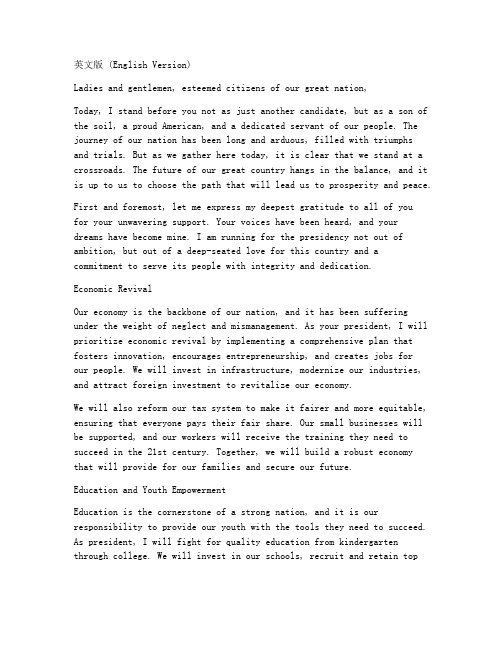
英文版 (English Version)Ladies and gentlemen, esteemed citizens of our great nation,Today, I stand before you not as just another candidate, but as a son of the soil, a proud American, and a dedicated servant of our people. The journey of our nation has been long and arduous, filled with triumphs and trials. But as we gather here today, it is clear that we stand at a crossroads. The future of our great country hangs in the balance, and it is up to us to choose the path that will lead us to prosperity and peace.First and foremost, let me express my deepest gratitude to all of youfor your unwavering support. Your voices have been heard, and your dreams have become mine. I am running for the presidency not out of ambition, but out of a deep-seated love for this country and a commitment to serve its people with integrity and dedication.Economic RevivalOur economy is the backbone of our nation, and it has been suffering under the weight of neglect and mismanagement. As your president, I will prioritize economic revival by implementing a comprehensive plan that fosters innovation, encourages entrepreneurship, and creates jobs for our people. We will invest in infrastructure, modernize our industries, and attract foreign investment to revitalize our economy.We will also reform our tax system to make it fairer and more equitable, ensuring that everyone pays their fair share. Our small businesses will be supported, and our workers will receive the training they need to succeed in the 21st century. Together, we will build a robust economy that will provide for our families and secure our future.Education and Youth EmpowermentEducation is the cornerstone of a strong nation, and it is our responsibility to provide our youth with the tools they need to succeed. As president, I will fight for quality education from kindergarten through college. We will invest in our schools, recruit and retain topeducators, and provide scholarships to those who dream of attending the best universities.We will also empower our youth by creating opportunities for them to engage in community service, entrepreneurship, and leadership programs. Our youth are the future of our nation, and it is our duty to equip them with the skills and knowledge they need to lead us into a brighter tomorrow.Healthcare for AllAccess to affordable healthcare is a fundamental right, and it is time we recognized it as such. As president, I will work tirelessly to ensure that every American has access to quality healthcare. We will expand Medicaid, implement a public option, and negotiate lower drug prices to make healthcare more affordable and accessible.We will also invest in public health initiatives to prevent disease and promote wellness. Our commitment to healthcare will not only save lives but also strengthen our economy by reducing healthcare costs for businesses and families.National Security and DefenseNational security is the bedrock of our democracy, and it is my solemn duty to protect our citizens and our interests. As president, I will ensure that our military is the finest in the world, equipped with the latest technology and trained to face any threat. We will invest in our intelligence agencies and work closely with our allies to combat terrorism and prevent conflicts.We will also prioritize cybersecurity and ensure that our digital infrastructure is secure from cyber threats. Our commitment to national security will keep our nation safe and our people secure.Environmental StewardshipThe health of our planet is inextricably linked to the health of our nation. As president, I will lead a national effort to combat climate change and protect our environment. We will invest in renewable energy,promote energy efficiency, and develop sustainable practices that will preserve our natural resources for future generations.We will also implement strict regulations to protect our air, water, and soil from pollution, ensuring that our children inherit a clean and healthy planet.Unity and InclusionOur nation is a tapestry of diverse cultures, beliefs, and backgrounds, and it is our strength. As president, I will work to unite our people, bridge divides, and promote inclusivity. We will ensure that every American, regardless of their race, gender, religion, or sexual orientation, has the opportunity to thrive and contribute to our great nation.ConclusionLadies and gentlemen, the future of our nation is in our hands. It is time for us to come together, to rise above our differences, and tobuild a future that is bright, just, and prosperous. I ask for your vote, your trust, and your support. Together, we will make America great again.Thank you, and God bless America.中文版 (Chinese Version)尊敬的女士们、先生们,我国伟大民族的同胞们,今天,我站在这里,不仅作为一个候选人,更作为一个生于斯、长于斯的美国人,一个对国家充满深爱的公民,一个致力于以诚信和奉献精神服务人民的忠诚仆人。
美国总统竞选
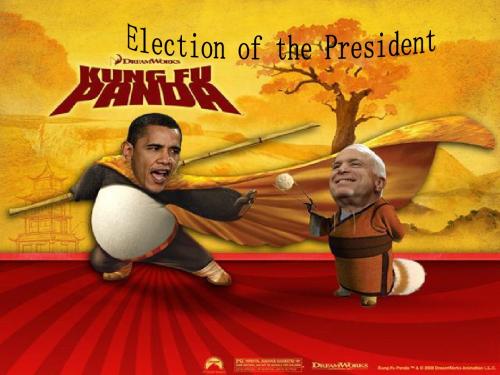
Step I: Primaries and Caucuses
There are many people who would like to become President. Each of these people have their own ideas about how our government should work. Some of these people can belong to the same political party. That's where primaries and caucuses come in. In these elections, party members get to vote for the candidate that will represent their party in the upcoming general election.
Step 2: National Conventions
At the end of the primaries and caucuses, each party holds a national convention to finalize the selection of one Presidential nominee. During this time, each Presidential candidate chooses a running-mate (or Vice-Presidential candidate).
The process of electing a President was set up in the United States Constitution. The Constitution requires a candidate for the presidency to be: At least 35 years old A natural born citizen of the United States A resident of the United States for 14 years
希拉里竞选美国总统演讲中英文
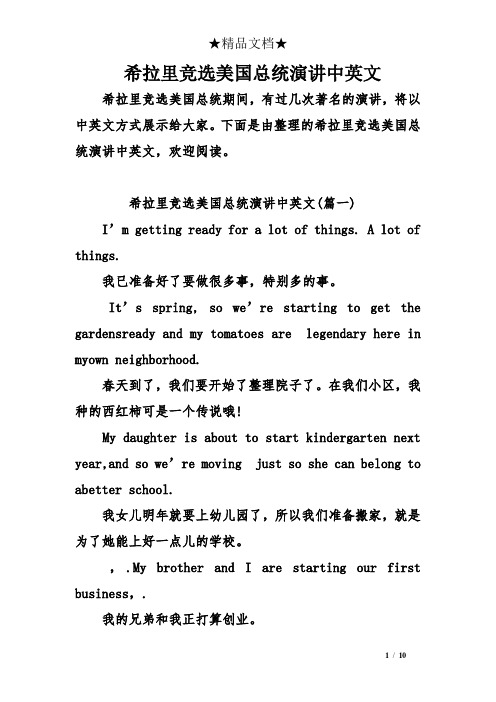
希拉里竞选美国总统演讲中英文希拉里竞选美国总统期间,有过几次著名的演讲,将以中英文方式展示给大家。
下面是由整理的希拉里竞选美国总统演讲中英文,欢迎阅读。
希拉里竞选美国总统演讲中英文(篇一)I’m getting ready for a lot of things. A lot of things.我已准备好了要做很多事,特别多的事。
It’s spring, so we’re starting to get the gardensready and my tomatoes are legendary here in myown neighborhood.春天到了,我们要开始了整理院子了。
在我们小区,我种的西红柿可是一个传说哦!My daughter is about to start kindergarten next year,and so we’re moving just so she can belong to abetter school.我女儿明年就要上幼儿园了,所以我们准备搬家,就是为了她能上好一点儿的学校。
,.My brother and I are starting our first business,.我的兄弟和我正打算创业。
After five years of raising my children, I am now going back to work.五年来我一直都在带孩子。
现在我要重返职场了。
Every day we’re trying to get more and more ready and more prepared. Baby boy, coming yourway.我们每天都在做准备。
现在准备是越来越充分了。
宝宝,来吧!Right now I’m applying for jobs. It’s a look into what the real world will look like after college.我刚刚申请了工作,对毕业后的真实世界充满了期待。
- 1、下载文档前请自行甄别文档内容的完整性,平台不提供额外的编辑、内容补充、找答案等附加服务。
- 2、"仅部分预览"的文档,不可在线预览部分如存在完整性等问题,可反馈申请退款(可完整预览的文档不适用该条件!)。
- 3、如文档侵犯您的权益,请联系客服反馈,我们会尽快为您处理(人工客服工作时间:9:00-18:30)。
Debate
Promote their image
BACK
National Election 全国选举
• The second Tuesday in November of the election year
Speech
If there is anyone out there who still doubts that America is a place where all things are possible; who still wonders if the dream of our founders is alive in our time; who still questions the power of our democracy, tonight is your answer.
It’s been a long time coming, but tonight, because of what we did on this date, in this election, at this defining moment, change has come to America.
Made by LYY
Preliminary Election 预选
• February to June in election year(大选年) • Grass-roots political parties 政党基层会议
or • Direct pre-selection meeting 直接预选
BACK
Presidential Nominating Convention 总统候选人提名大会
• July and August in election year
BACK
Election Campaign 竞选运动
• After the national congress until the presidential election date • Aim: getting more votes
If you are going to run for the American president…… 1.Preliminary Election 3.Election Campaign
5.ElHale Waihona Puke ctoral College Vote
2.Presidential Nominating Convention 4.National Election
It’s the answer spoken by young and old, rich and poor, Democrat and Republican, black, white, Hispanic, Asian, Native American, gay , straight, disabled and not disabled— Americans who sent a message to the world that we have never been just a collection of individuals or a collection of Red States and Blue States: we are, and always will be, the United States of America.
It’s the answer that led those who’ve been told for so long by so many to be cynical, and fearful, and doubtful about what we can achieve to put their hands on the arc of history and bend it once more toward the hope of a better day.
BACK
Electoral College vote 选举团投票表决
• 270 votes !
Thank you ~
It’s the answer told by lines that stretched around schools and churches in numbers this nation has never seen; by people who waited three hours and four hours, many for the first time in their lives, because they believed that this time must be different; that their voices could be that difference.
